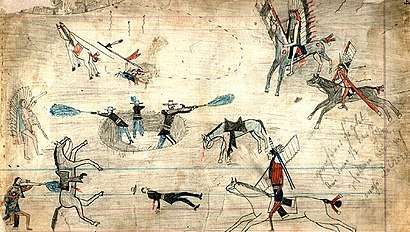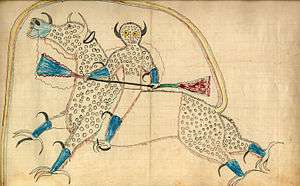Ledger art
Ledger art is a term for Plains Indian narrative drawing or painting on paper or cloth. Ledger art flourished primarily from the 1860s to the 1920s. A revival of ledger art began in the 1960s and 1970s. The term comes from the accounting ledger books that were a common source of paper for Plains Indians during the late 19th century.

Historical precedents

Ledger art evolved from Plains hide painting.[1] Among Plains tribes, women traditionally paint abstract, geometrical designs, whereas men paint representational designs. The men's designs were often heraldic devices or visions painted on shields, tipis, shirts, leggings, or robes. Before the Plains tribes were forced to live on reservations in the 1870s, men generally painted personal feats in battle or hunting.[2] Plains ledger art depicted communally acknowledged events of valor and tribal importance in order to gain status for the individuals who participated in them, and their band and kin. Plains pictorial art emphasizes narrative action and eliminates unnecessary detail or backgrounds.[3] Figures tended to be drawn in hard outlines and filled with solid fields of color.[4]
These were all traditionally painted on animal hides – particularly buffalo hides. When buffalo became scarce after eradication programs encouraged by the US federal government, Plains artists began painting and drawing on paper, canvas, and muslin.[1]
New materials
An increasing supply of ledger books and other paper came from traders, government agents, missionaries, and military officers.[5] With these came pencils, ink fountain pens, crayons, and watercolor paints.[6] These new tools allowed for greater detail and experimentation than the earlier tools, such as bone or wood styli dipped in mineral pigments, had. The compact ledger books and pencils were highly portable, making them ideal for nomadic lifestyles.[7]
Fort Marion

The most celebrated ledger artists were prisoners of war at Fort Marion in St. Augustine, Florida. In 1874, in what became known as the Red River War or Buffalo War, a group of Cheyenne, Kiowa, Comanche, warriors fought the US Army to protect the last free herd of buffalo and to assert their autonomy.[8] In the harsh winter of 1874 to 1875, many tribal camps were forced to surrender to various Indian agencies, and the supposed leaders of the Red River War were rounded up and sent to Fort Marion.[9] From 1875 to 1878, the 71 men and one woman were under the command of Richard Henry Pratt, who used the opportunity to give the Indians a Western education.[10]
He also provided the prisoners with basic art supplies, such as pencils, ink, crayons, watercolor paint, and paper.
Twenty-six of the Fort Marion prisoners engaged in drawing. They were younger Cheyenne, Arapaho, and Kiowa men.[11] Some of the most prolific and well-known artists include Paul Caryl Zotom (Kiowa); David Pendleton Oakerhater or Making Medicine (Cheyenne); Tichkematse or Squint Eyes (Cheyenne), who later worked for the Smithsonian Institution in Washington, DC; Wohaw (Kiowa); Howling Wolf (Cheyenne); Etahdleuh Doanmoe (Kiowa); White Bear (Arapaho); Koba (Kiowa); and Bear’s Heart (Cheyenne). Tichtematse, Howling Wolf, White Bear, and Koba all continued drawing after their release from prison.[12]
Subject matter
.jpg) Karl Bodmer facsimile of Ledger art
Karl Bodmer facsimile of Ledger art Red Horse Ledger art of Lakota Killed at Little Bighorn. Published as Plate XLIV
Red Horse Ledger art of Lakota Killed at Little Bighorn. Published as Plate XLIV_(19367428281).jpg) Red Horse Ledger art of Lakota killed at Little Bighorn. Published as PLate XLV
Red Horse Ledger art of Lakota killed at Little Bighorn. Published as PLate XLV
Battle exploits dominated ledger art. Other traditional themes such as hunting, courtship,[13] and religious practices were common subjects. Ledger artists also documented their rapidly changing environment by portraying encroaching European Americans and new technologies such as trains and cameras. Many ledger artists worked with ethnologists, by documenting shield and tipi designs, ethnobotanical information, winter counts, dance customs and regalia, and other cultural information. Dreams and visions inspired ledger art just as they had inspired earlier hide paintings.[14]
The artists creating ledger art today often reference pre-reservation lifeways, historical transitions, and social commentary. They use this style to illustrate cultural continuity between historical and contemporary Native life.[13]
As fine art

Missionaries, anthropologists, and tourists eagerly collected ledger books in the late 19th century. Carl Sweezy (Southern Arapaho, 1881–1953) and Haungooah (Silver Horn) (Kiowa, 1860–1940) both established professional careers as ledger artists.
These early Southern Plains easal artists in turn inspired the Kiowa Six. These artists painted with Western art-grade materials and met with international success when they exhibited their work in the 1928 International Art Congress in Prague, Czechoslovakia.
Today
Numerous Northern and Southern Plains artists create ledger paintings, today, including many women artists despite Plains narrative figuritive painting being a masculine art genre in the past.[15] Many seek out 19th-century documents on which to paint, creating ironic juxtapositions between the printed text and the paintings. Dwayne Wilcox (Oglala Lakota) uses the style of 19th-century Lakota painters to express humorous views of modern realities for Lakota people. Arthur Amiotte (Oglala Lakota) builds upon the collage aspect of ledger art and combines text, photography, naturalistic painting and stylized Plains pictorial art in his work. Dolores Purdy Corcoran (Caddo/Winnebago) is a woman ledger artist who uses bright colors and female figures frequently in her work.[16]
Notable ledger artists
- Yellow Nose-Ute, captured as a Child by Cheyenne. Dog Soldier Warrior Society Member
- Amos Bad Heart Bull, Oglala Sioux
- Black Hawk, Sans Arc Lakota
- Howling Wolf, Cheyenne
- Jaw (Ćehu′pa) or His Fight (Okicize Tawa) (ca. 1853-1924), Hunkpapa Lakota, Amidon Ledger[1]
- Lauren Good Day - Ledger art, beadwork, quillwork, parfleche, clothing & fashion artist. Arikara, Hidatsa, Blackfeet & Plains Cree descent.
- Michael Horse, Yaqui-Mescalero Apache-Zuni-descent[13]
- St. David Pendleton Oakerhater, CheyenneBow String Warrior Society Member
- George Curtis Levi-Southern Cheyenne, Arapaho-Ledger Art, Parfleche, Native Fashion
- Silver Horn, Kiowa
- Sitting Bull, Hunkpapa Lakota[17]
- White Horse, Kiowa
- Robert "Running Fisher" Upham, Dakota Sioux, Salish[18]
Notes
- "Ledger Art History." Department of Ethnic Studies, University of California San Diego: Plains Indian Ledger Art Project. 2011 (retrieved 2 Oct 2011)
- Hansen, 138
- Greene, 11
- Greene, 63
- Swan, 70
- Hansen, 139
- Greene, 13
- Szabo, 12–14
- Szabo, 14
- Szabo, 25
- Szabo, 29
- Szabo, 110
- Fauntleroy, Gussie. "Ledger Art: Looking Between the Lines." Native Peoples. Sept/Oct 2011 (retrieved 7 Aug 2011)
- Hansen, 140
- Pearce, p. xiii
- Fauntleroy, Gussie. "Ledger art: Looking between the lines." Native Peoples. Sep–Oct 2011. Retrieved 9 Oct 2013.
- view=&dsort=&date.slider=&q=Sitting+Bull+drawing+-%22Four+Horns%22&fq=online_visual_material%3Atrue "Sitting Bull's ledger drawings." Smithsonian Institution Collections Search Center. (retrieved 14 Aug 2010)
References
- Greene, Candace S. Silver Horn: Master Illustrator of the Kiowas. Norman: University of Oklahoma Press, 2001. ISBN 0-8061-3307-4.
- Hansen, Emma I. Memory and Vision: Arts, Cultures, and Lives of Plains Indian People. Cody, WY: Buffalo Bill Historical Center, 2007. ISBN 0-295-98580-1.
- Pearce, Richard. "Women and Ledger Art: Four Contemporary Native American Artists." University of Arizona Press, 2-13. ISBN 978-0-8165-2104-3.
- Swan, Daniel C. Peyote Religious Art: Symbols of Faith and Belief. Jackson: University of Mississippi Press, 1999. ISBN 1-57806-096-6.
- Szabo, Joyce M. Art from Fort Marion: The Silberman Collection. Norman: University of Oklahoma Press, 2007. ISBN 978-0-8061-3883-1.
External links
| Wikimedia Commons has media related to Ledger art. |
- Ledger drawings in the Smithsonian Institution's collections
- Ledger Art Collection at the Milwaukee Public Museum
- Plains Indian Ledger Art Project, University of California, San Diego
- Keeping History: Plains Indian Ledger Drawings, Online exhibition from Smithsonian Institution